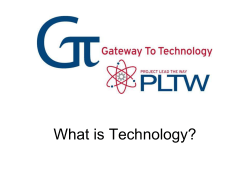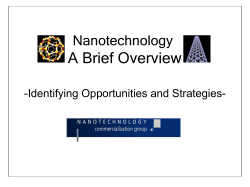
NANOTECHNOLOGY IN FOOD SCIENCE
NANOTECHNOLOGY IN FOOD SCIENCE KEY TERMS MEMS – three dimensional objects that perform a mechanical function, whose dimensions are between 1 to 100 micrometers Nanoparticle – a particle of material at the nanoscale Nanotechnology – a material or structure purposefully manufactured with dimensions between 1 and 100 nanometers to leverage the unique properties it has at that size Nanoemulsion – two ingredients that don’t mix well; particles around 50 nanometers in diameter Nanofood – nanoparticles are used during cultivation, production, processing, or packaging of the food Nanocomposites - a multiphase solid material where one of the phases has one, two or three dimensions of less than 100 nanometers (nm), or structures having nano-scale repeat distances between the different phases that make up the material http://en.wikipedia.org/wiki/Nanocomposite Nanosphere – a round particle with nanoscale proportions Nanosensors - any biological, chemical, or sugery sensory points used to convey information http://www.absoluteastronomy.com/topics/Nanosensor Nano bubbles - very small (tens of nanometers in diameter) that adhere to the surface of some solids placed in a liquid environment. http://nanobillboard.com Nanocapsule - A colloid whose particles have dimensions measured in nanometres, especially such an emulsion of water and oil or biological lipids http://en.wiktionary.org/wiki/nanocapsule Food fortification - the public health policy of adding micronutrients (essential trace elements and vitamins) to foodstuffs to ensure that minimum dietary requirements are met http://en.wikipedia.org/wiki/Food_fortification UNIT OBJECTIVES 1. List components of nanofood. 2. Name ways nanotechnology is incorporated into food science. 3. Describe benefits of food at the nanoscale. 4. Discuss the controversy with nanotechnology in foods. 5. List major companies integrating nanotechnology into food. 6. Describe nanotechnology in food packaging. 7. 8. 9. 10. 11. Discuss nanotechnology in food production. Describe nanotechnology in food storage. List health benefits of nanotechnology in foods. Discuss nanotechnology in food processing. List expected salaries for skilled nanotechnology workers. 12. List Oklahoma schools offering courses in nanotechnology. NANOFOOD • Food is considered a nanofood when nanoparticles are used during cultivation, production, processing, or packing of the food. It does not mean atomically modified food or food produced by nanomachines. http://www.nutritioninformation.us/nutrition.htm • Nanotechnology is having an impact on several aspects of food science from how food is grown to how it is packaged. • Companies are developing nanomaterials that will make a difference not only in the taste of food, but also in food safety, and the health benefits that food delivers. WHY NANOTECHNOLOGY? Better packaging Improved storage Contamination sensor Improving texture and flavor Additives are used to improve taste, texture, nutritional value, and safety Industry analysts predict that nanotechnology will be used to transform food from the atom up. Food will be wrapped in smart safety packaging that can detect spoilage or harmful contaminants. Food fortification will be used to increase the nutritional claims that can be made about a given processed food. WHY GO NANOSCALE? • It allows manufacturers to combine ingredients that weren’t possible before as well as adding ingredients to end-use products that you otherwise couldn’t. An example of this is white bread with Omega-3. http://starbakers.in/productspage/bread/ CONTROVERSY WITH NANO IN FOODS The failure of governments to introduce laws to protect the public and the environment from nanotechnology’s risks is a serious concern. Manipulating the atomic levels of food is a concern. There is a concern that nanoparticles are more reactive, more mobile, and more likely than larger particles to be toxic to humans and the environment. The use of nano-surveillance in food packaging is a privacy concern to consumers. The manipulating of atomic levels is being argued that it will result in food that is safer. Nanoparticles which are included in food packaging or storage are not intentionally included in the food, but there is a chance these particles may migrate into food. MAJOR FOOD AND NUTRITION COMPANIES INTEGRATING NANOTECHNOLOGY • • • • • • H.J. Heinz Nestle Hershey Unilever Campina General Mills • • • • • • Friesland Food Grolsch Kraft Foods Cargill Pepsi-Cola Company ConAgra Foods • Biacore’s micro fluidic chip technology is being used to ensure consistent vitamin content in fortified foods, testing for antibiotics in honey and screening for veterinary drug residue in livestock and poultry. http://starbakers.in/products-page/bread/ • When we make some foods nanostructures naturally form. When making jams, jellies, curds, custards, and sauces, the cooking and cooling process results in the melting and recrystallization of carbohydrates at the nanoscale. http://selmaala.blogspot.com/2010/12/jams-n-jellies.html • Aquanova provides a good representative example of the application of nanotech to food • Novasol is a nanosome about 30 nanometers in diameter. http://repro.tuc-repro.de/?id=1015 • OilFresh 1000 is a thin ceramic plate used in deep fat fryers in restaurants to slow the breakdown of the oil so restaurants can fry food faster • This helps restaurants use less oil and save money. The food will not absorb as much oil either http://www.abssimplythebest.com/Used_Equipment_Page.html • Nanoparticles are being developed that will deliver vitamins or other nutrients in food and beverages without affecting the taste or appearance. http://southwerk.wordpress.com/2010/11/11/gold-nanoparticles/ FOOD PACKAGING • Nanocomposites are used in food packaging to improve the barrier of plastic films and bottles which results in food staying fresh longer http://www.sustainabilityninja.com/recycling-sustainability/waterbottles-pure-water-and-pure-evil-66819/ • Plastic wrap is made up of hundreds of individual layers that are a few nanometers thick. http://www.alibaba.com/product-gs/380237621/Plastic_wrap.html • Clay nanocomposites are being used to provide an impermeable barrier to gasses in lightweight bottles, cartons, and packaging films http://accelrys.com/resource-center/casestudies/archive/studies/nanocomposites2.html http://www.trippauctionservices.com/listings/details/index.cfm?ite mnum=775198149 • Storage bins are being produced with silver nanoparticles embedded in the plastic. The silver nanoparticles kill bacteria from any material that was previously stored in the bins, minimizing health risks from harmful bacteria • Smart packaging is being developed that will be capable of detecting food spoilage and releasing nano-antimicrobes to extend food shelf life. This will allow supermarkets to keep food longer. http://www.chipsbooks.com/smartpac.htm • Nanotechnology will extend food shelf life by having an invisible, edible, nano wrapper which will envelope foods preventing gas and moisture exchange. http://www.chipsbooks.com/smartpac.htm • Smart packaging could release a dose of additional nutrients to those which it identifies as having special dietary needs, for example calcium molecules to people suffering from osteoporosis http://altmed.creighton.edu/hypertension/Nutritional%20Supplem entation.htm • Antibodies attach to fluorescent nanoparticles to detect chemicals or foodborne pathogens • Biodegradable nanosensors are used for temperature, moisture, and time monitoring http://science.csustan.edu/confocal/Images/Chuck/fitc.htm • Nanoclays and nanofilms act as barrier materials to prevent spoilage and prevent oxygen absorption • Electrochemical nanosensors detect ethylene http://www.sciencelearn.org.nz/ScienceStories/Microorganisms/Sci-Media/Images/Mouldy-fruit • Lighter, stronger, and more heat-resistant films with silicate nanoparticles • Modified permeation behavior of foils http://touchtresbien.com/tag/aluminum-foil/ CARDBOARD • A new adhesive made from nanoparticles of starch is keeping labels and other graphics stuck to fast food containers. http://www.365waysprogram.com/2010/12/preschoolactivities-13-ways-to-have-fun-with-cardboard/ FOOD PRODUCTION • Nano-bubbles of ozone with micro-bubbles of an ozone/oxygen mix is used to clean seafood. http://www.scallywagsresort.com/scallywags_bar_grill.html • Kraft and Nestle are designing smart foods that will interact with consumers to personalize food by changing color, flavor, and nutrients on demand. http://elgrecoinc.com/Suppliers.html • Kraft is developing a clear tasteless drink that contains hundreds of flavors in latent nanocapsules http://www.jelsert.com/for-your-business/about-jelsert.aspx • A domestic microwave could be used to trigger release of color, flavor, concentration, and texture of the individual’s choice. • Smart foods could also sense when an individual is allergic to a food’s ingredients http://www.vivax.com/default.aspx?tabid=804&newsType=Article View&articleId=5138 FOOD STORAGE The SAMSUNG refrigerator and food containers, Fresher Longer, are coated with antimicrobial nanosilver particles http://www.asseenontvfrenzies.com/Product/1381/Always_Fresh _Containers.aspx HEALTH BENEFITS • The inclusion of medically beneficial nano-capsules will soon enable chocolate chip cookies or hot chips to be marketed as health promoting or artery cleansing http://crossroadsofamerica.blogspot.com/2011/01/chocolate-chip-andpecan-cookies.html • Nanotechnology will enable junk foods like ice cream and chocolate to be modified to reduce the amount of fats and sugars that the body can absorb http://barefootandbaking.blogspot.com/2010/07/fresh-strawberry-icecream.html FOOD PROCESSING • Nanocapsules to improve bioavailablility of neutraccuticals in standard ingredients such as cooking oil http://www.domesticsale.com/Classifieds/480036.html • Nanotubes and nanoparticles act as gelation agents • Nanocapsule infusion of plant based steroids to replace a meat’s cholesterol http://bbq.about.com/od/steaks/ss/aa110108a.htm • Nanoparticles selectively bind and remove chemicals or pathogens from food • Nanoemulsions and particles for better availability and dispersion of nutrients http://www.weightlosspatchesreview.com/slimming-patchesguides/best-vegetables-for-weight-loss Nanotechnology is a young and growing field An estimated two million skilled nanotechnology workers will be needed worldwide by the year 2015 – one million of them in the U.S. Graduates are receiving salary offers up to $55,000 per year with a two-year degree Graduates with a baccalaureate degree can expect salary offers up to $65,000 per year Students who choose to continue their education can expect salary offers of $100,000 OKLAHOMA SCHOOLS OFFERING COURSES Oklahoma City Community College Oklahoma State University Oklahoma University Tulsa Community College Tulsa University REFERENCES • • • • • • • • • • • • • • • • • • • • www.nanotechproject.org www.foodproductiondaily.com www.azonano.com www.sciencedaily.com/releases/2008/12/081228194854.htm www.scientificamerican.com www.thefreelibrary.com/nanotechnology www.leatherheadfood.com/nano-nutrition www.anythingbutwork.com/health/nanotechnology.htm www.globalresearch.ca/index www.nanowerk.com http://nano.foe.org.au www.understandingnano.com http://spectrum.ieee.org www.sourcewatch.org www.reuters.com www.ncbi.nlm.nih.gov/books www.ars.usda.gov www.nanocor.com Richard Booker and Earl Boysen, Nanotechnology for Dummies, Indianapolis, Indiana, 2005. Marlene Bourne, A Consumer’s Guide to MEMS and Nanotechnology, Scottsdale, AZ, 2007. This module is one of a series designed to introduce faculty and high school students to the basic concepts of nanotechnology. Each module includes a PowerPoint presentation, discussion questions, and hands-on activities, when applicable. The series was funded in part by: The National Science Foundation Grant DUE-0702976 and the Oklahoma Nanotechnology Education Initiative Any opinions, findings and conclusions or recommendations expressed in the material are those of the author and do not necessarily reflect the views of the National Science Foundation or the Oklahoma Nanotechnology Education Initiative.
© Copyright 2025














